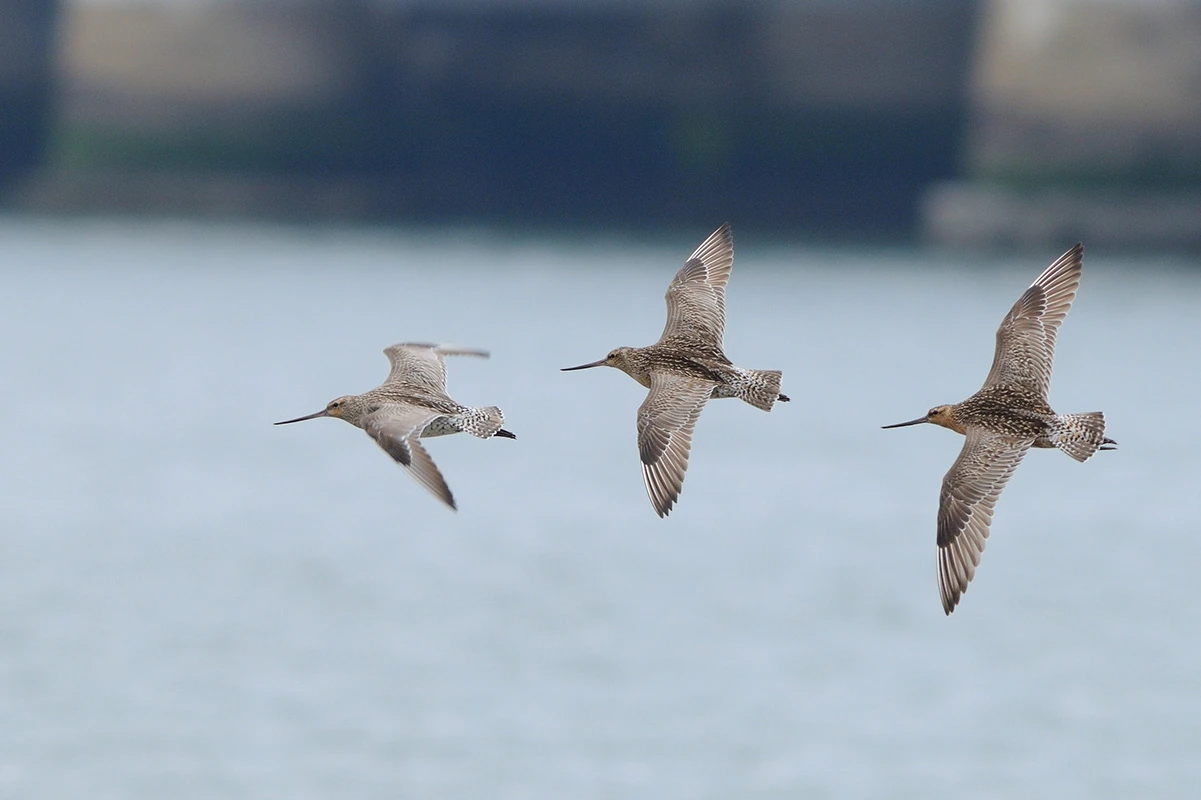Haunui waka at the 2011 Festival of Sail in San Diego, California.
Image credit: Haunui waka by Michael R Perry. Flickr. Some rights reserved: CC BY 2.0. Image brightened and saturated.
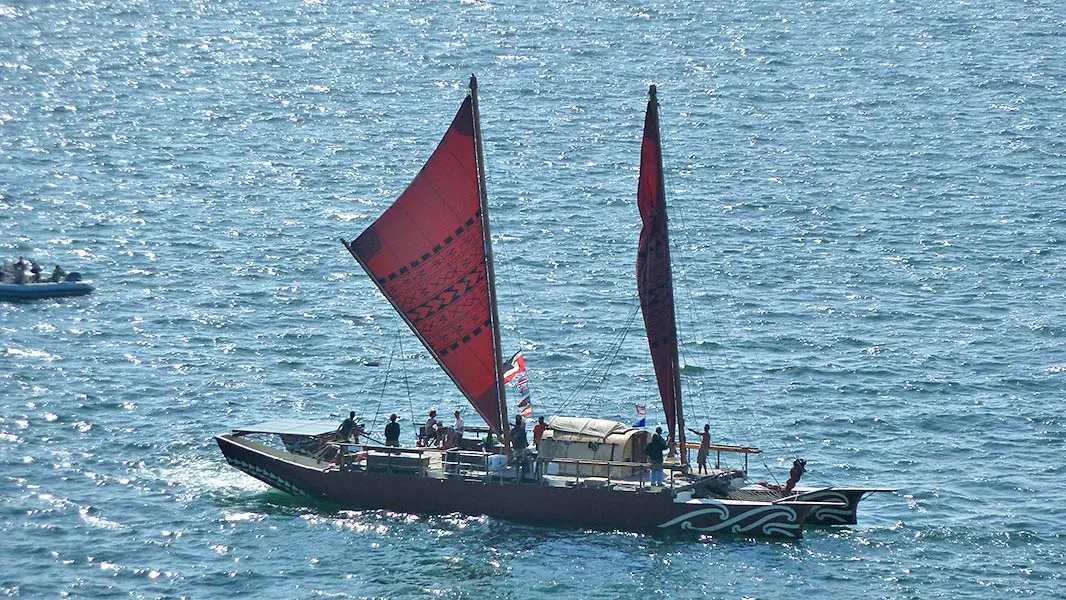

E 'ike ka hoku o ka nalu, o hoku 'ula, o hoku lei.
Behold the stars of the waves, the red star, the wreath of stars.
Whakamārama: I te rewanga me te hekenga o ngā whetu ki te urunga pae, ki reira tohu ai i te arai.
Meaning: When the rising and setting stars are near the ocean horizon, they provide clues to direction.
Source: Voyaging proverbs — from a chant in the story of Paka'a and Kuapaka'a.
E whakatere ana koe i tō waka i te moana uriuri, e mōhio ana koe kei hea rawa koe, i ahu mai koe i hea, ā, e haere ana koe ki hea. Me āta kukume koe i ngā moutere kia whakatata mai ki a koe.
Mō ngā iwi o Te Moana-nui-a-Kiwa, he hanga noa iho te haere mā te moana, kāore i rerekē i te hīkoi noa. Mai rā anō ko te moana te kāinga o te tangata — te matua, te kaitiaki, te kaihora i te kai, te kaiako, te kaitūhono i ngā iwi.
I a koe e hī ana, ka mārama haere koe ki ngā pikinga me ngā hekenga, ngā tini pūtanga kētanga o te hau, o te kapua, o te ngaru. Mehemea he pākiki, he mataara hoki koe, ka kite wawe anō koe i ngā tohu e whakaatu ana ki a koe 'arā kē te whenua!'.
Anei tētahi kaponga iti o ēnei mātauranga, he mea tuku iho mō te hia mano tau.
Sailing your waka on the vast ocean, you know where you are, you know where you've come from, and you know where you're going. You just have to draw the islands towards you.
For the people of Te Moana-nui-a-Kiwa, travelling by sea is as natural as walking. The ocean has always been home — the parent, the protector, the provider, the teacher, the connector.
Out fishing, you learn to see patterns in the wind, clouds, and waves. If you're curious and alert, you'll soon see the signs that tell you, 'land is that way!'.
Here's a snapshot of this knowledge, passed on for thousands of years.
Haunui waka at the 2011 Festival of Sail in San Diego, California.
Image credit: Haunui waka by Michael R Perry. Flickr. Some rights reserved: CC BY 2.0. Image brightened and saturated.

Mau Piailug with son Stan conducting a navigation class (pa'afu).
Image credit: Mau Piailug with son Stan conducting navigation class (pa'afu) outdoor in Nemaenong Village, Satawal Island, 1983 by Steve Thomas. Ref: 4-D-01-07 University of Hawai'i-Mānoa Library — Pacific Collection. All rights reserved. Used with permission.
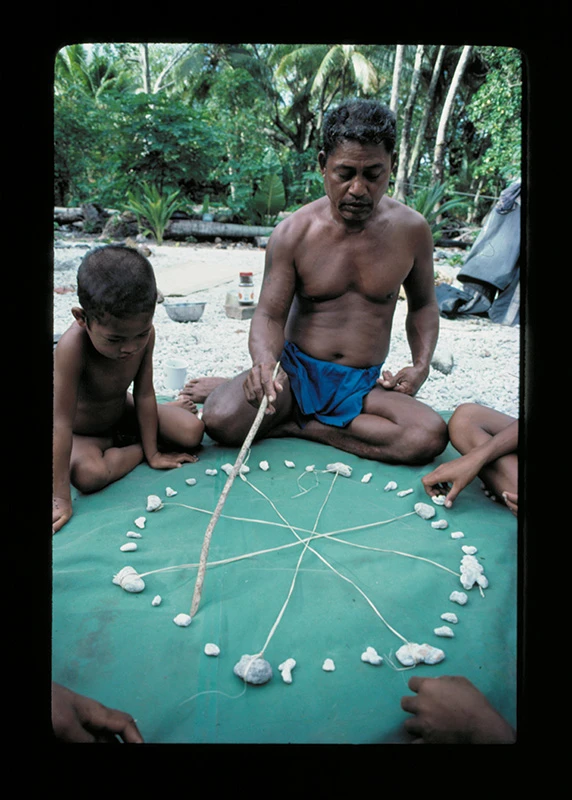
Mā ngā whetū e ārahi te ihu o tō waka i tō terenga roa. E whakapono ana ngā kaiwhakatere o Te Moana-nui-a-Kiwa he tūpuna ngā whetū, e tohu nei te ara mō rātou.
He mea tino nui hoki te rā me te marama: he wā tino hira te whitinga me te tōnga o te rā hei āta whakatikatika i te kawenga o te ihu o te waka.
Stars help you keep your waka on track during your voyage. Pacific voyagers believe stars are tūpuna (ancestors), showing them the way.
The sun and moon are super important too: sunrise and sunset are important times to fine-tune the direction you're sailing in.
Sailing under the stars at sunset.
Image credit: Star reflection by Johannes Plenio. Unsplash. License to use.
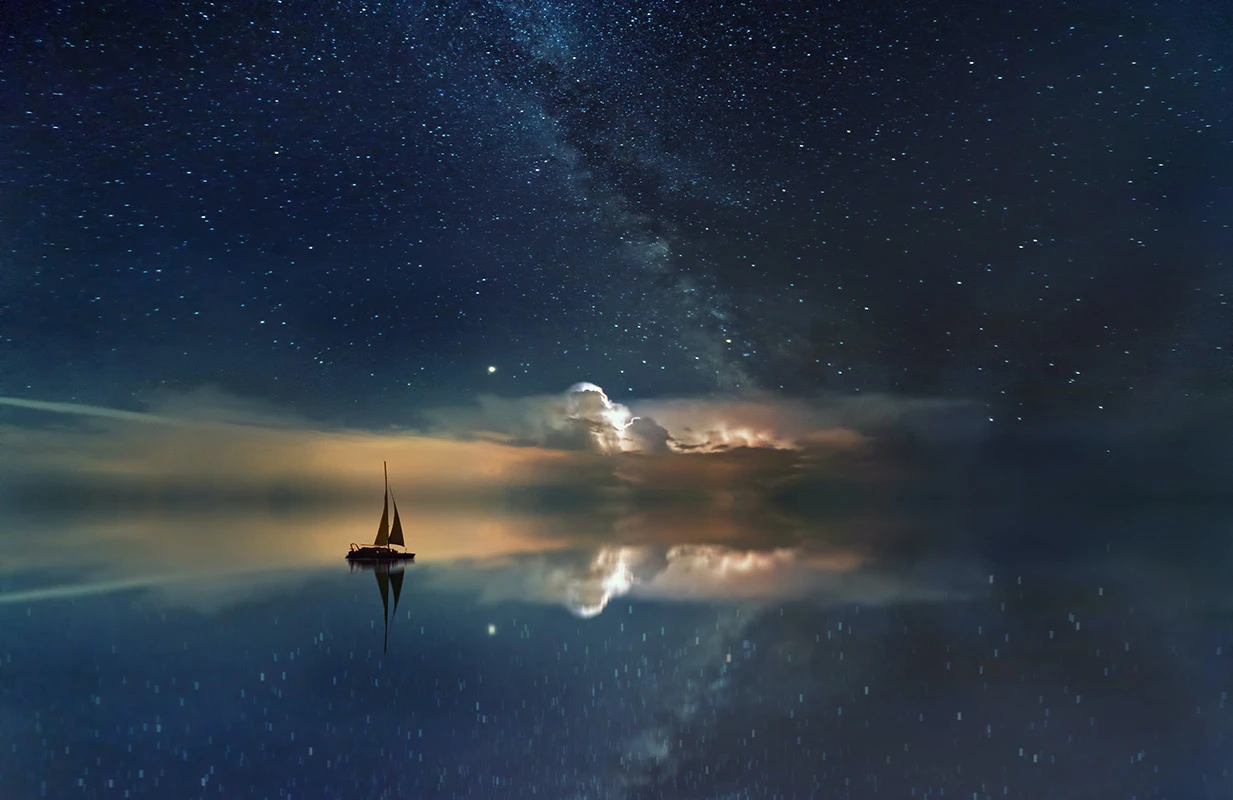
Ko tā te kapua he whakawātea i ngā rā kei mua ki ō kanohi. Mā ngā kapua ka kitea e koe ngā huarere e haere mai ana, ahakoa i ngā rā tawhiti atu, mehemea ka piki te hau, ka mahi rānei kia pūhia atu koe i tō ara.
I ētahi wā ka noho tonu ngā kapua ki runga ake i te whenua, pēnei i te tohu whenua. I ētahi wā ka whakaatatia te kikorangi o ngā roto, kia kitea te āhuatanga o te roto i raro o te kapua, waihoki ngā kākāriki uriuri o ngā moutere whai ngahere nui, ka pērā anō.
Clouds let you see into the future. They can tell you what weather is coming, even days away, and if the winds will speed you up or blow you off course.
Clouds often sit above land, like signposts. Their white undersides can reflect the teal blue of lagoons and deep greens of forested islands.
Clouds above an island in the Federated States of Micronesia.
Image credit: Federated States of Micronesia. Asian Development Bank on Flickr. Some rights reserved: CC BY-NC-ND 2.0.
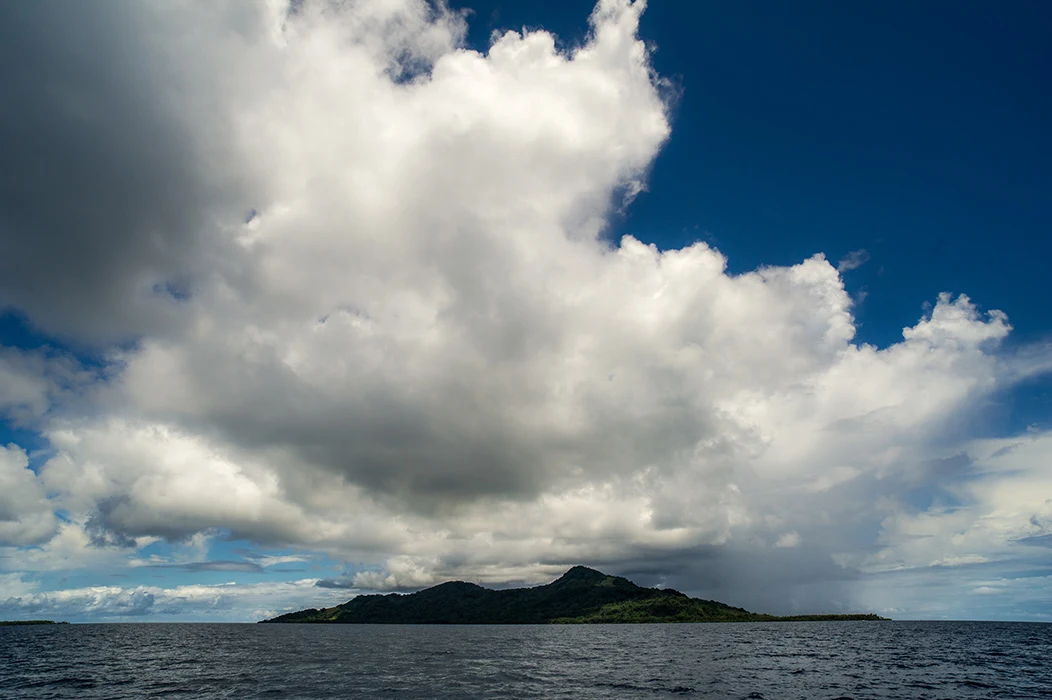
Mā te kukume o te moana ka mōhio koe ki te āhua o ngā huarere e haere mai ana, kei hea rawa hoki te whenua.
Ka taea e ngā kaiwhakatere waka o Te Moana-nui-a-Kiwa te tautohu i tō rātou ahunga mā te aro atu ki ngā āmai hōhonu o te moana, nā ngā tūpuhi nui mamao i whakaara, ā, ka taea ngā moutere te kite mā te 'rongo' i te āhua o ngā āmai e papaki atu ana ki ngā moutere me ngā moutere toka rārangi me te hoki whakamuri anō aua āmai ki ngā waka.
The way the ocean moves can tell you what weather is coming, and which direction land is.
Pacific navigators can set their course using deep ocean swells caused by far-off storms, and find islands by 'feeling' the swell bouncing off islands and atolls.
Swell patterns around an island.
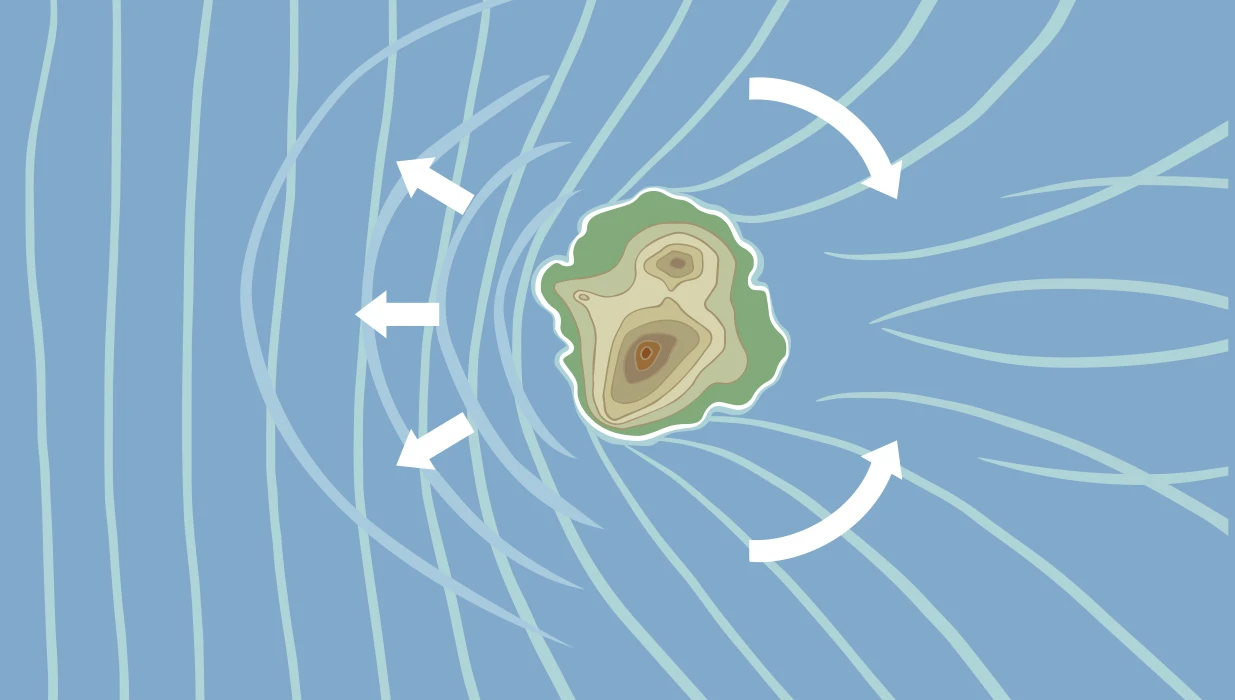
He āwhina nui te manu mōu i roto i ngā rā o tō terenga moana.
Ina kitea e ngā kaihōpara tuatahi o Te Moana-nui-a-Kiwa ngā manu o uta e ahu ana ki te uru-mā-tonga, i mōhio rātou me ahu pērā atu rātou. I whai anō rātou i te koekoeā me te pīpīwharauroa mā runga i Te Moana-nui-a-Kiwa.
Tā te manu nei te tara he whakamōhio i a koe kāore koe i te tawhiti rawa i tētahi whenua. Ka rere atu aua manu ki te moana i te ata, ka hoki ki tōna kōhanga i te tōnga o te rā.
Pīpīwharauroa, shining cuckoo.
Image credit: Shining cuckoo: dorsal view of adult, Wanganui, November 2012 by Ormond Torr. New Zealand Birds Online. All rights reserved. Used with permission.

Koekoeā, long-tailed cuckoo.
Image credit: Long-tailed cuckoo: adult calling in flight, Blowhard Bush, Hawke's Bay, January 2015 by Adam Clarke. New Zealand Birds Online. All rights reserved. Used with permission.
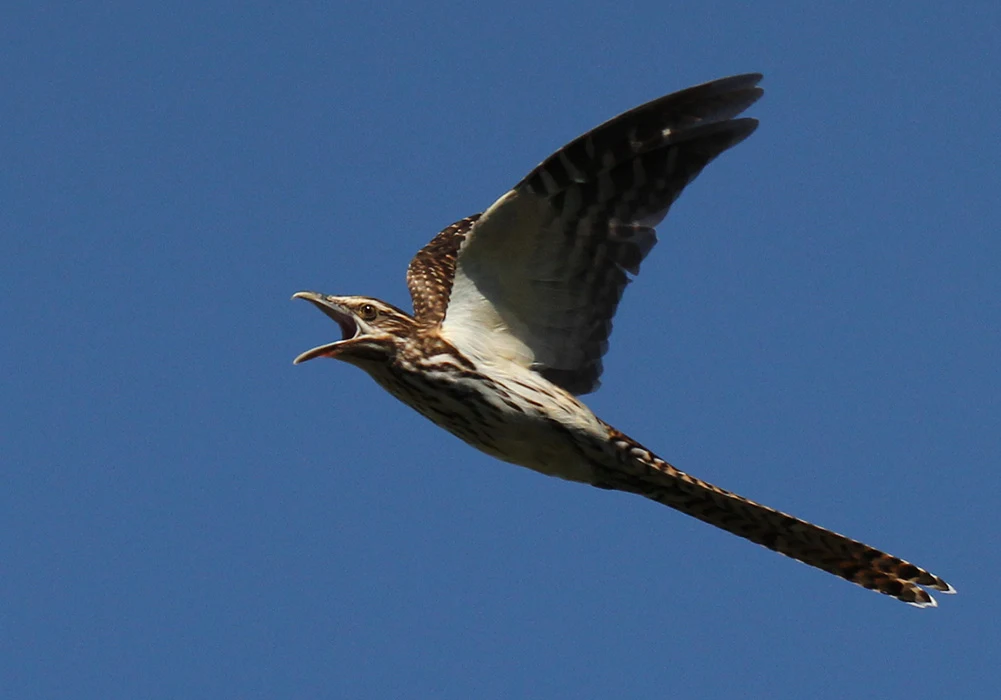
Birds are a big help throughout your journey.
When the first Pacific explorers saw land birds migrating south-west, they knew they should head in that direction. They followed koekoeā (the long-tailed cuckoo) and pīpīwharauroa (the shining cuckoo), across Te Moana-nui-a-Kiwa.
Birds like tara (terns) tell you when land is close by. They fly out to sea at daybreak, and back to their nests at dusk.
Ko te kaupapa waka ki te moana hoe ai, ko te kāhui atua ki te rangi rere ai.
E ai ki ngā kōrero tuku iho nā ngā kuaka ngā kaihōpara whenua i ārahi mai ki tēnei whenua.
Rere ai te kuaka i Alaska ki Aotearoa ia tau, ia tau, ki te kai - he tawhiti kē ātu ōna takanga i te ao i ētahi katoa atu o ngā manu pīrere o te ao. Ki ētahi tāngata Māori, hei kaiārahi ngā manu nei i ngā wairua o te hunga mate i te hokinga ki te kāinga tūturu.
I ēnei rā, kei te noho mōrea ēnei manu kautū. Kei te ngarongaro haere ngā wāhi kai mō rātou, nā reira e mahi tahi ana ngā kaipūtaiao ki te whakaora i ngā ripoinga tūturu o ngā manu nei.
Migration route of kuaka.
Image credit: Bar-tailed godwits' migration route by Te Ara, using information from 'Movements of banded Arctic waders to and from New Zealand' by Adrian C. Riegen, Notornis 46. Te Ara — The Encyclopedia of New Zealand. All rights reserved. Used with permission.
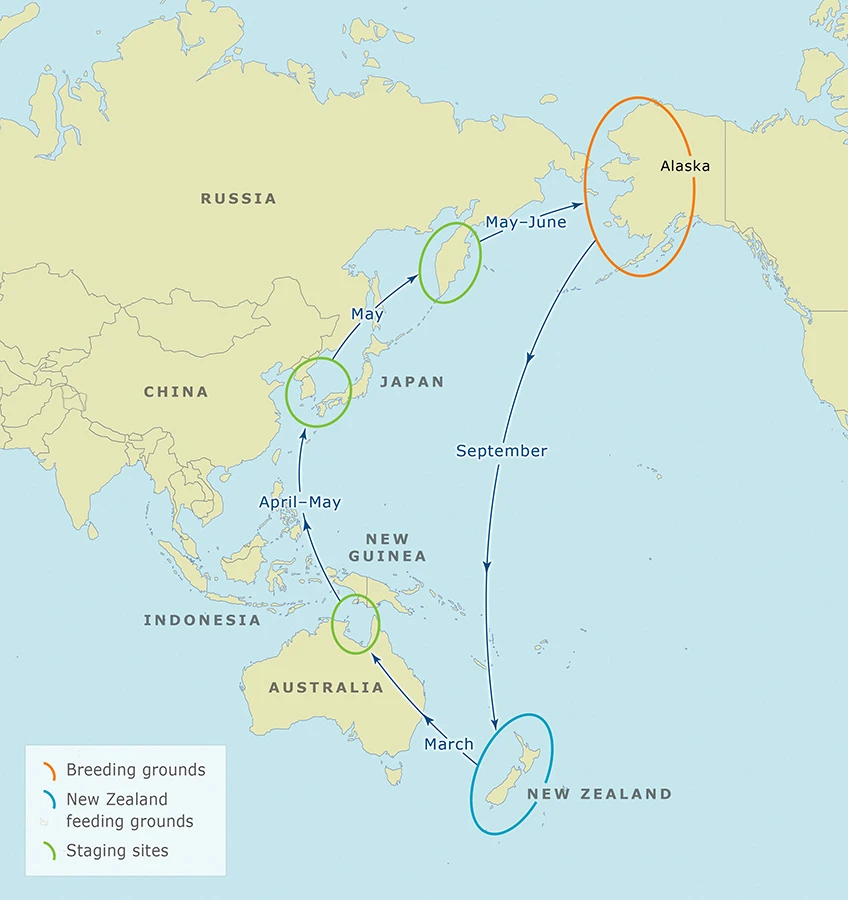
Kuaka, bar-tailed godwit.
Image credit: In search for nibbles by Stefan Marks. Flickr. Some rights reserved: CC BY-NC-ND 2.0.

Our canoes paddle the ocean; gods with wings fly over our heads.
It's said that kuaka (bar-tailed godwits) helped guide Pacific explorers to this land.
Kuaka fly non-stop from Alaska to Aotearoa every year to feed — farther than any other migrating bird. Some Māori believe they accompany the spirits of the departed on their path home.
Today, these small wading birds are at risk. The places where they can feed are shrinking, so scientists are working together to restore their habitats.
Kuaka in flight.
Image credit: Bar-tailed godwit in flight by KazKuro. Flickr. Some rights reserved: CC BY-NC-ND 2.0.
